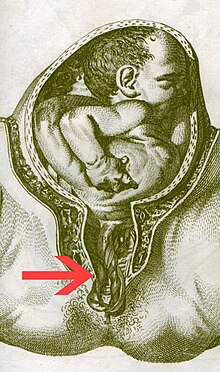
Back تدلي الحبل السري Arabic Prolapse del cordó umbilical Catalan Nabelschnurvorfall German Prolapso del cordón umbilical Spanish فروافتادگی بند ناف Persian Procidence du cordon French צניחת חבל הטבור HE Prolaps tali pusat ID Prolasso del funicolo ombelicale Italian 臍帯脱出 Japanese
| Umbilical cord prolapse | |
|---|---|
| Other names | Cord prolapse, prolapsed cord[1] |
 | |
| Cord prolapse, as depicted in 1792 | |
| Specialty | Obstetrics |
| Risk factors | Abnormal position of the baby, prematurity, twin pregnancy, multiple prior pregnancies[2][3] |
| Diagnostic method | Suspected based on a sudden decrease in baby's heart rate during labor, confirmed by seeing or feeling the cord in the vagina[4] |
| Differential diagnosis | Abruptio placentae[2] |
| Treatment | Rapid delivery, usually by cesarean section.[4] |
| Prognosis | Risk of death of the baby 10%[2] |
| Frequency | < 1% of pregnancies[4] |
Umbilical cord prolapse is when the umbilical cord comes out of the uterus with or before the presenting part of the baby.[2] The concern with cord prolapse is that pressure on the cord from the baby will compromise blood flow to the baby.[2] It usually occurs during labor but can occur anytime after the rupture of membranes.[1][5]
The greatest risk factors are an abnormal position of the baby within the uterus and a premature or small baby.[2] Other risk factors include a multiple pregnancy, more than one previous delivery, and too much amniotic fluid.[2][3] Whether medical rupture of the amniotic sac is a risk is controversial.[2][3] The diagnosis should be suspected if there is a sudden decrease in the baby's heart rate during labor.[4][2] Seeing or feeling the cord confirms the diagnosis.[4]
Management focuses on quick delivery, usually by cesarean section.[4] Filling the bladder or pushing up the baby by hand is recommended until this can take place.[4] Sometimes women will be placed in a knee-chest position or the Trendelenburg position in order to help prevent further cord compression.[2] With appropriate management, the majority of cases have good outcomes.[4]
Umbilical cord prolapse occurs in about 1 in 500 pregnancies.[2] The risk of death of the baby is about 10%.[2] However, much of this risk is due to congenital anomalies or prematurity.[2] It is considered an emergency.[4]
- ^ a b "Umbilical Cord Prolapse". DynaMed. 30 November 2018. Retrieved 10 October 2019.
- ^ a b c d e f g h i j k l m Lore, Marybeth (March 2017). "Umbilical Cord Prolapse and Other Cord Emergencies". The Global Library of Women's Medicine. doi:10.3843/GLOWM.10136.
- ^ a b c Sayed Ahmed, WA; Hamdy, MA (2018). "Optimal management of umbilical cord prolapse". International Journal of Women's Health. 10: 459–465. doi:10.2147/IJWH.S130879. PMC 6109652. PMID 30174462.
- ^ a b c d e f g h i Holbrook, BD; Phelan, ST (March 2013). "Umbilical cord prolapse". Obstetrics and Gynecology Clinics of North America. 40 (1): 1–14. doi:10.1016/j.ogc.2012.11.002. PMID 23466132.
- ^ "Umbilical cord prolapse in late pregnancy" (PDF). 2015. Retrieved 12 October 2019.
© MMXXIII Rich X Search. We shall prevail. All rights reserved. Rich X Search